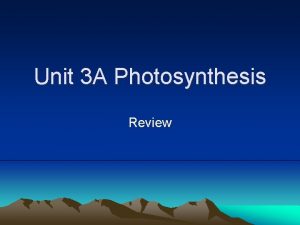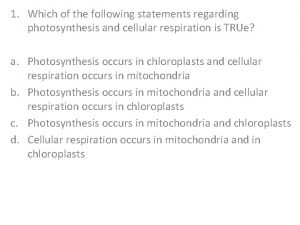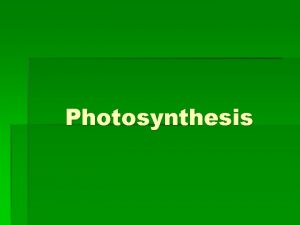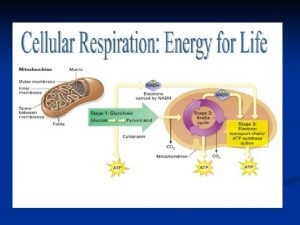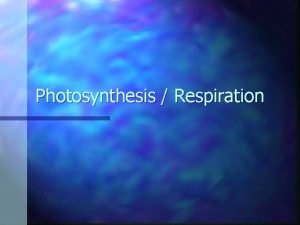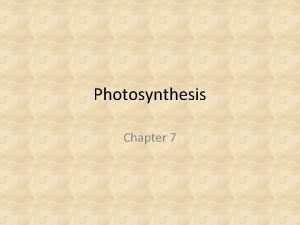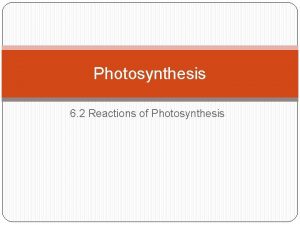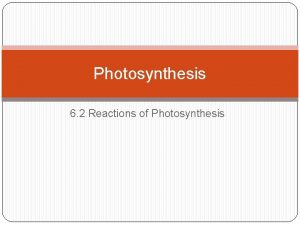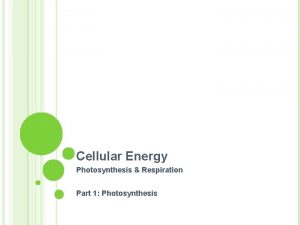Photosynthesis Photosynthesis Which of the following is a






















- Slides: 22

Photosynthesis

Photosynthesis

Which of the following is a product of photosynthesis? A. Water B. Glucose C. Carbon Dioxide D. Sunlight

In addition to sunlight, what are the other reactants for the process of photosynthesis? A. Water and oxygen B. Water and glucose C. Oxygen and carbon dioxide D. Water and carbon dioxide

Pigments of Photosynthesis Pigments are molecules that absorb specific wavelengths (energies) of light and reflect all others. Chlorophyll is the main pigment in charge of capturing the energy from sunlight.

• Chlorophyll a absorbs ……………. . light best. • Chlorophyll b absorbs ……………. light best. • Why do plants look green? • THEY RELFECT GREEN LIGHT!!!

Chloroplast Structure

Chlorophyll is a pigment in the chloroplast that A. stores and releases energy B. absorbs sunlight C. Carries high energy electrons D. Makes glucose

Chloroplasts do not contain which of the following structures? A. Mitochondria B. Thylakoids C. Stroma D. Chlorophyll

What is the process in which autotrophs trap the energy from the sun and store this energy in molecules such as glucose. A. Predation B. Metabolism C. Cell Respiration D. Photosynthesis

1. Write down 3 observations of the diagram below. 2. Share with a partner. 3. Share with the class! Discuss!! H 2 O

Remember ATP? ? ATP Adenosine triphosphate 3 phosphate groups ADP Adenosine diphosphate 2 phosphate groups Compound that cells use to store and release energy

Chemical Energy and ATP

Electron Carrier Molecules Compound that can accept a pair of high energy electrons and transfer them, along with most of their energy to another molecule One way the sunlight can be trapped in a chemical form and use it to build glucose for the plant cell Example: NADP+ = accepts and holds 2 high energy electrons along with a hydrogen ion (H+) When NADP+ accepts 2 electrons and a H+ it becomes NADPH

Photosynthesis: Step 1 – Light-Dependent Reaction Takes place in Thylakoids. Chlorophyll absorbs light energy from the sun. Water is then split into hydrogen (H) and oxygen (O). The oxygen is released to the atmosphere. Produces NADPH and ATP for the Calvin Cycle (step 2)! H 2 O IN Sunlight Water ADP NADP+ OUT Oxygen ATP NADPH

Photosynthesis: Step 2 – Light-Independent Reaction Takes place in Stroma. Also called the Calvin Cycle or Dark Reactions. CO 2 (carbon dioxide) combines with hydrogen (H) to form C 6 H 12 O 6 (glucose). The NADPH made in the light- dependent reactions provides the Hydrogen for the glucose The ATP made in light-dependent reactions provides the energy for the Calvin Cycle to occur. IN Carbon Dioxide ATP NADPH OUT Glucose NADP+ ADP

What affects the rate of photosynthesis? Amount of : - sunlight - CO 2 - H 2 O - temperature All the reactions of photosynthesis are controlled by enzymes. Temperatures above or below the optimum temperature will slow down the chemical reactions.

GET YOUR CLICKERS!

Energy from the sun is collected during the: A. Light- independent reactions B. Light-dependent reactions C. Thylakoid reactions D. Krebs Cycle

Glucose is created during this step of photosynthesis. A. Light- independent reaction B. Lightdependent reaction C. Thylakoid reactions D. Krebs Cycle

Which of the following would not directly impact the growth of a plant? A. Spectrum of light B. Concentration of oxygen C. Concentration of carbon dioxide D. Availability of water E. Temperature

Which of the following is NOT produced in the lightdependent reactions? 1. NADPH 2. Sugars 3. Hydrogen Ions 4. ATP
 Which of the following equations represents photosynthesis?
Which of the following equations represents photosynthesis? Consider the following statements regarding photosynthesis
Consider the following statements regarding photosynthesis Hát kết hợp bộ gõ cơ thể
Hát kết hợp bộ gõ cơ thể Slidetodoc
Slidetodoc Bổ thể
Bổ thể Tỉ lệ cơ thể trẻ em
Tỉ lệ cơ thể trẻ em Gấu đi như thế nào
Gấu đi như thế nào Tư thế worm breton
Tư thế worm breton Hát lên người ơi alleluia
Hát lên người ơi alleluia Môn thể thao bắt đầu bằng chữ đua
Môn thể thao bắt đầu bằng chữ đua Thế nào là hệ số cao nhất
Thế nào là hệ số cao nhất Các châu lục và đại dương trên thế giới
Các châu lục và đại dương trên thế giới Công của trọng lực
Công của trọng lực Trời xanh đây là của chúng ta thể thơ
Trời xanh đây là của chúng ta thể thơ Cách giải mật thư tọa độ
Cách giải mật thư tọa độ Phép trừ bù
Phép trừ bù Phản ứng thế ankan
Phản ứng thế ankan Các châu lục và đại dương trên thế giới
Các châu lục và đại dương trên thế giới Thơ thất ngôn tứ tuyệt đường luật
Thơ thất ngôn tứ tuyệt đường luật Quá trình desamine hóa có thể tạo ra
Quá trình desamine hóa có thể tạo ra Một số thể thơ truyền thống
Một số thể thơ truyền thống Cái miệng nó xinh thế
Cái miệng nó xinh thế Vẽ hình chiếu vuông góc của vật thể sau
Vẽ hình chiếu vuông góc của vật thể sau
